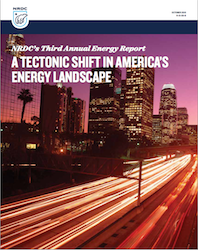America’s energy economy has never been better according to a new report, “A Tectonic Shift in America’s Energy Landscape,” from the Natural Resources Defense Council (NRDC). One key finding is that innovative energy saving techniques have enabled the country to more than double its economic productivity from oil, natural gas and electricity over the past 40 years. This means, finds the report, that energy efficiency has contributed more to meeting the country’s needs than all other resources combined.
 “Although the nation’s energy news has trended from bad to worse for decades, we’ve seen a remarkable turnaround, much of it due to the huge and inexpensive resource of energy efficiency — getting more out of every energy dollar,” said Ralph Cavanagh, NRDC co-director of the energy program. “But you’d never know it from those who want to build the massive KXL pipeline, ratchet up oil and gas drilling, launch a nuclear renaissance or embrace an ‘all of the above’ energy policy.”
“Although the nation’s energy news has trended from bad to worse for decades, we’ve seen a remarkable turnaround, much of it due to the huge and inexpensive resource of energy efficiency — getting more out of every energy dollar,” said Ralph Cavanagh, NRDC co-director of the energy program. “But you’d never know it from those who want to build the massive KXL pipeline, ratchet up oil and gas drilling, launch a nuclear renaissance or embrace an ‘all of the above’ energy policy.”
NRDC’s First Annual Energy and Environment Report, America’s (Amazingly) Good Energy News, is the product of a detailed, extensive analysis of recent government data that shows total U.S. energy use in 2012 was below the 1999 level even though the economy grew by more than 25 percent (adjusted for inflation) during that period. This result, shows the report, is that factories and businesses are producing substantially more products and value with less energy, the amount of gasoline per mile driven is down, and the cost of all energy services (from lighting to refrigeration) also has decreased.
“These energy reductions are saving hundreds of billions of dollars every year, helping U.S. workers and companies compete worldwide, and making our country more secure,” added Cavanagh.
The report notes that the amount of climate-warming carbon dioxide pollution also is down, putting the nation on track to meet President Obama’s emissions reduction target of 17 percent over the next seven years, though much more must be done, says NRDC, to avoid the worst effects of climate change.
Here is a snapshot of several of the report’s major findings:
ELECTRICITY: Since 2000, for the first time in modern history, the rate of growth in electricity use has dropped well below the rate of population growth.
RENEWABLE ENERGY: Wind power led all competitors – both renewables and fossil fuels – in terms of new generating capacity installed over the course of 2012 and solar power also is surging; but even more impressive was the 24-fold increase in wind-produced electricity from 2000 to 2012.
ENERGY EFFICIENCY – Energy efficiency standards and financial incentives, underwritten mostly by the utility industry, have dramatically reduced both the energy intensity and costs of energy. And new fuel economy standards are reducing America’s oil imports by more than 2 million barrels per day.
Cavanagh concluded, “The report is a powerful rebuttal of the ill-considered ‘all of the above’ energy philosophy, which is both unaffordable and environmentally irresponsible. We should learn from forty years of economy-wide demonstrations that the fastest, cheapest, and cleanest energy solutions all involve getting more work out of less electricity, oil and natural gas.”

